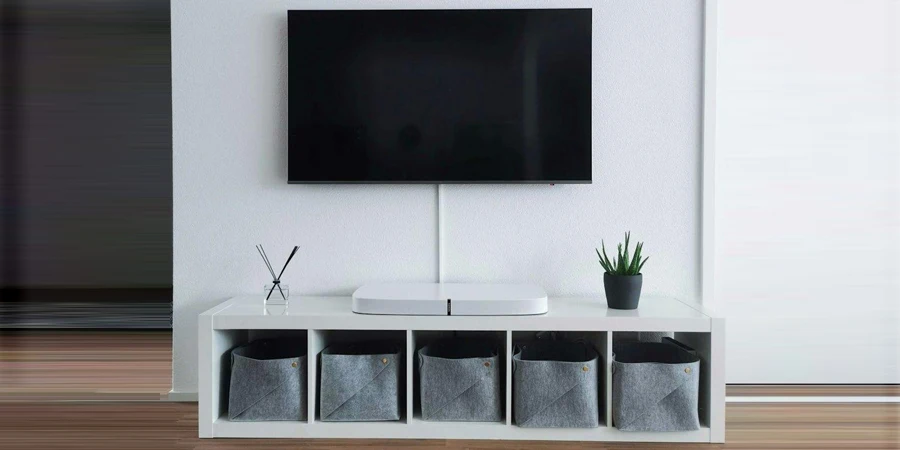Table of Contents
● Introduction
● Market overview
● Mount types and their features
● Things to consider when selecting TV mounts
● Conclusion
Introduction
Selecting the appropriate TV mount or cart is a critical decision for businesses and resellers, impacting both the operational functionality and the aesthetic integration in professional environments. As televisions increase in size and sophistication, choosing a mounting solution that supports substantial weights and blends seamlessly into a variety of business settings is crucial. The correct mount can significantly enhance space efficiency, provide optimal viewing angles, and uphold a professional appearance. Offering a range from fixed designs to adjustable full-motion models, each mount type presents unique advantages tailored to specific commercial needs. For resellers, understanding these nuances is essential to guide clients towards making informed, beneficial choices.
Market overview

Current market size and expected growth
The TV mount market has demonstrated solid growth and is forecasted to continue its upward trajectory, with projections suggesting it will expand from USD 1819.5 million in 2020 to USD 2127.1 million by 2032, achieving a compound annual growth rate (CAGR) of 1.3% during this period. This growth is largely driven by the increasing consumer inclination towards larger television screens, necessitating robust and versatile mounting solutions to accommodate their size and weight. As screens become more expansive, the demand for reliable and space-efficient mounting options becomes more pronounced, highlighting the need for mounts that not only support larger TVs but also contribute to optimal space utilization in both residential and commercial settings.
Insights into market drivers
Advancements in technology are profoundly shaping consumer preferences, with smart features and sophisticated functionalities becoming integral to the market. The integration of motorized adjustments and remote control operations exemplifies this trend, enhancing user convenience and compatibility with smart home systems. For instance, the adoption of motorized mounts, which allow for adjustments in TV angles with the push of a button, has seen significant uptake. These technological enhancements are increasingly aligned with consumer expectations for functionality and ease of use, driving further growth in the sector.
Mount types and their features
Fixed mounts

Fixed mounts represent the most straightforward solution in the TV mounting space, noted for their low cost and ease of installation. These mounts are ideal for settings where the TV does not need to be moved for different viewing angles, such as in conference rooms or waiting areas where the audience is generally static. According to Mounting Dream, fixed mounts provide a stable, flush appearance that can help maintain the minimalist design of modern spaces. Their simplicity allows for quick installation, often requiring fewer tools and less time than more complex mount types, making them a cost-effective option for large-scale deployments in business environments.
Full motion mounts
Full motion mounts offer the highest level of adjustability, including the ability to tilt, swivel, and extend the TV from the wall. This type of mount is particularly beneficial in multi-purpose rooms or areas where viewers watch from various angles. For instance, some models allow for full-range motion, facilitating optimal viewing from different parts of a room. This versatility makes full-motion mounts a popular choice in commercial settings such as sports bars or retail spaces where viewing flexibility can significantly enhance the customer experience.
Tilting mounts
Tilting mounts provide a specific advantage for installations where TVs are mounted above eye level, such as over fireplaces or in bedrooms. These mounts allow for vertical adjustments, typically between 5° and 15°, which helps reduce glare and improve sight lines for a more comfortable viewing experience. As noted by Mounting Dream, tilting mounts combine the stability of a fixed mount with the added flexibility of angle adjustment, making them suitable for both residential and commercial applications where the screen needs to be positioned higher on the wall.
Ceiling and under-cabinet mounts
For spaces where wall mounting is not feasible, ceiling and under-cabinet mounts offer innovative alternatives. Ceiling mounts are ideal for commercial spaces like gyms or public transportation terminals, where wall space is limited but overhead installation is possible. These mounts can often rotate and tilt, providing excellent visibility in large, open areas. Under-cabinet mounts, on the other hand, are perfect for use in kitchens or in RVs, where they can be tucked away neatly under storage units, maximizing space efficiency while still providing clear visibility. Both options reflect the industry’s move towards versatile mounting solutions that cater to unique installation needs and optimize viewing in non-traditional environments.
Each of these mount types brings distinct benefits to different installation scenarios, allowing businesses to tailor their offerings to meet specific customer needs effectively. By understanding the features and advantages of each mount type, resellers can provide valuable insights to customers, ensuring they choose the right product for their particular circumstances.
Things to consider when selecting tv mounts
When selecting TV mounts, it is important to consider a range of factors to ensure both functionality and compatibility with the viewing environment. Here’s a detailed look at these considerations:
Wall type compatibility

Different wall constructions, such as concrete or wooden studs, require specific types of mounts tailored to their structural characteristics. For wooden stud walls, mounts that support single stud installation are often recommended for their robustness and flexibility. For example, some models are designed for easy centering on walls with 16″, 18″, or 24″ studs and can support televisions up to 132 lbs. On the other hand, concrete walls may require mounts with special anchors or masonry-compatible hardware to ensure a secure installation, reflecting the need for mounts that are specifically engineered for the material they attach to.
TV specifications and VESA compatibility
Ensuring that a mount supports the TV’s size, weight, and VESA compatibility is crucial. The VESA standard refers to the pattern of mounting holes on the back of the TV, measured in millimeters. For example, a VESA pattern of 400×400 means the holes are spaced 400mm apart horizontally and vertically. Mounts must match these dimensions to fit properly. Larger screens, such as those over 55 inches, typically require a mount with a higher weight capacity and a wider VESA pattern, highlighting the importance of checking these specifications to avoid mismatches that could lead to installation problems or damage.
Flexibility and viewing experience
The choice of mount type significantly affects viewing flexibility and comfort. Fixed mounts are suitable for environments where the viewing position does not change, offering stability and a low profile. Full-motion mounts, like the Mounting Dream MD2380, allow for extensive adjustments including tilting, swiveling, and extending from the wall, which is ideal for rooms where viewers watch from different angles. These mounts are particularly useful in commercial settings such as bars or restaurants, where viewing angles might vary greatly. Tilting mounts provide a vertical adjustment, usually between 5° and 15°, which helps in reducing glare and improving the viewing angle for audiences in tiered seating arrangements.
Installation requirements
The complexity of the installation process can vary significantly between mount types. While fixed mounts can often be set up quickly and with minimal tools, full-motion mounts might involve a more complex installation that could require professional assistance. For example, the installation of a full-motion mount might involve configuring multiple pivot points and ensuring the mount can safely retract and extend without stressing the wall. Businesses should consider these factors when advising customers, as a straightforward installation not only enhances user satisfaction but also reduces the likelihood of improper setup and potential damage.
Overall, a detailed understanding of these technical aspects will enable businesses to provide tailored advice to customers, ensuring they select the most appropriate TV mount for their specific needs, thus enhancing both safety and viewing experience.
Conclusion

Throughout this discussion, this guide has explored the various aspects of selecting the ideal TV mount or cart, emphasizing the importance of aligning the choice with specific environmental needs and television specifications. From understanding the critical features of fixed, full motion, and tilting mounts to considering innovative solutions like ceiling and under-cabinet mounts, the right selection can significantly enhance both the functionality and aesthetic appeal of any space. For businesses, making informed choices about these products is not just about meeting immediate practical needs but also about maximizing long-term customer satisfaction and visual harmony in diverse settings. Thus, the careful selection of TV mounts and carts is crucial for optimizing viewing experiences and integrating technology seamlessly into everyday environments.




